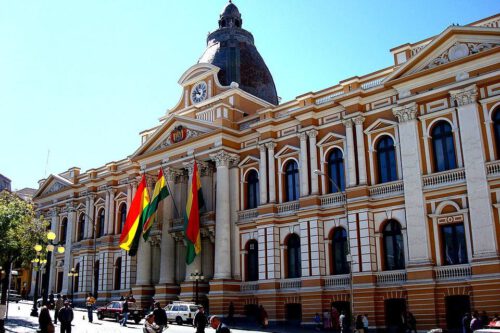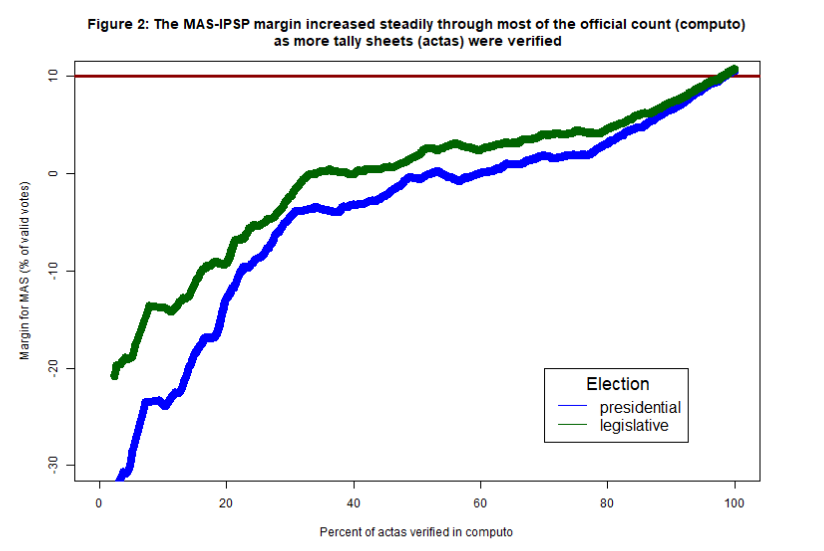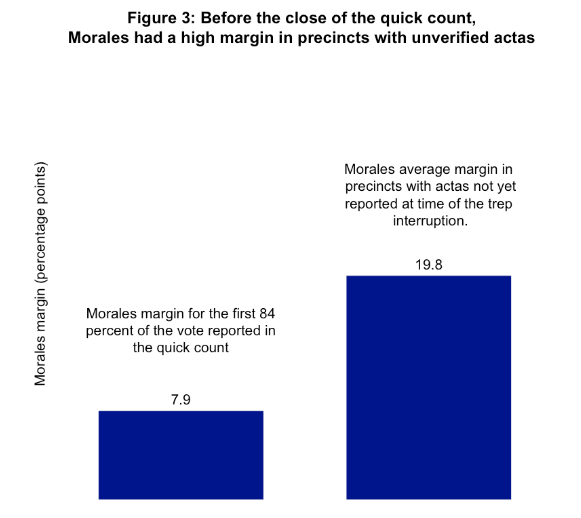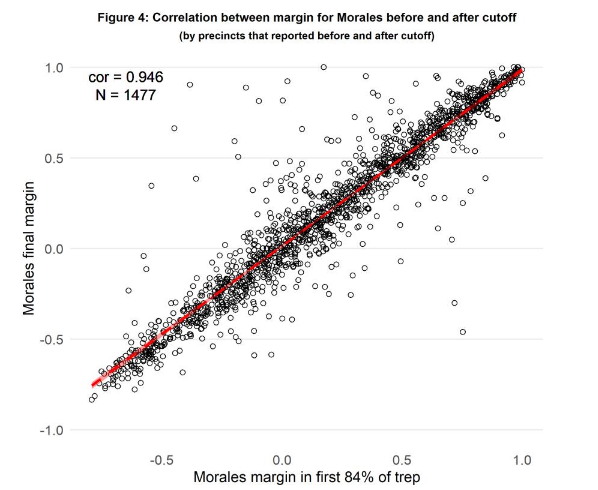Report
Analysis of the 2019 Bolivia Election

Report
Fact-based, data-driven research and analysis to advance democratic debate on vital issues shaping people’s lives.
Center for Economic and Policy Research
1611 Connecticut Ave. NW
Suite 400
Washington, DC 20009
Tel: 202-293-5380
Fax: 202-588-1356
https://cepr.net
Disclosure: In December 2019, the Center for Economic and Policy Research (CEPR) contracted with the authors to see if the numerical and statistical results of CEPR’s November 2019 study could be independently verified. Any analysis and interpretation of findings in this report express the sole views of the authors.
En español | Post on The Washington Post’s Monkey Cage blog
On October 20, 2019, Bolivia held its third general election under its 2009 constitution. Nine presidential candidates competed in the presidential election, but early polling indicated a likely two- way race between President Evo Morales of the Movimiento al Socialismo (MAS-IPSP) and former president Carlos Mesa of Comunidad Ciudadana (CC).
On the day of the election, the unofficial, preliminary count (trep) stopped at 7:40 PM, with only around 84% of the tally sheets (actas) that would be counted in the official count (computo) counted. On October 21 at 18:29, after the OAS Electoral Observation Mission in Bolivia requested a resumption of the trep, electoral officials announced updated results with 95 percent of actas processed. Morales’ margin in the updated results exceeded 10 percentage points. The OAS released a statement expressing concern about a “change in the trend” between results before and after the stopping of the trep on October 201.
In the final tally of the computo, Morales’s margin of victory would rise to 10.56 percentage points over CC candidate Mesa. Bolivian presidential elections require a 10 percentage point lead over the runner-up, and the change in the margin of victory in favor of Morales following the trep interruption was characterized as surprising and of “deep concern” by the OAS, thereby creating the impression that fraud in favor of MAS-IPSP had likely taken place.
We find that Morales’s victory can be explained by his voter support before the preliminary vote count halted. Through three analyses of the vote prior to the cutoff at 84% of the vote count, we find the final result can be explained by a pattern in the vote count prior to the cutoff of the trep. Therefore, we cannot find quantitative evidence of an irregular trend as claimed by the OAS.
Figure 1 plots the margin for MAS-IPSP by the percent of the final vote verified for the presidential and legislative Elections. Earlier in the vote count and prior to the stopping of the trep, there was a trend in the presidential vote count in favor of MAS-IPSP. As seen, despite early results in favor of CC, the margin for MAS-IPSP began to rise as early as 10% of the way through the vote count.
Following 20% of the vote, the trend in favor of MAS-IPSP is constant. Further, early vote reporting is highly variable as the number of actas is extremely low.

Further, the results seen in the trep are mirrored in the computo, which saw no interruption in the verification of vote totals. Figure 2 displays how votes in the legislative election and presidential election initially favored CC, but as more votes were counted they began to favor MAS-IPSP.

The goal of this study is to determine the extent to which the final vote results for Morales can be explained from analyzing the first 84% of precincts alone. In this analysis, we would expect that the margin of victory for Morales would be similar in actas within the same precinct whether they were verified before or after the closing of the preliminary count.
When the trep halted, precincts with actas remaining to be counted already highly favored Morales. Figure 3 shows that the precincts with actas remaining on average supported Morales by a 19.8 percentage point margin before the cutoff.

The margin in the right column of Figure 3 is an average by precinct and does not account for the varying size of precincts, nor does it account for the small percentage of precincts with no actas counted before the interruption. Given that, we thought it would be useful to see individual trends in reporting for precincts before and after the halting of the trep. 58.11% (N=2805) of precincts reported all actas before the cutoff, 11.29% (N=545) of precincts reported no actas before the cutoff, and 30.59% (N=1477) of precincts reported actas both before and after the cutoff.
Figure 4 analyzes those precincts that reported both before and after the halting of the trep. There is a strong relationship within precincts between voting margins reported before and after the cutoff, with the change in the trend nearly intersecting at zero in the figure. This provides a strong indication that within precincts there was no clear change in favor of a single party after the trep interruption.
Despite no change in the parties’ margins before and after the cutoff, we do see an increase in the overall margin for Morales in this group from 7.29 percentage points before the cutoff to 20.12 percentage points after the cutoff. This results from three trends in the group of precincts that reported before and after the cutoff. First, CC-favoring precincts on average reported 41% more votes than Morales-favoring precincts prior to the cutoff, while those Morales-favoring precincts reported 7% more after the cutoff. Of the 1477 precincts that reported before and after the cutoff, 66% of those precincts favored Morales. Finally, precincts favoring Morales supported him on average by 46 percentage points, while those favoring CC did so only by around 28 percentage points both before and after the cutoff.

Considering the strong relationship between precinct margins, we estimate the margin of votes verified after the interruption based on the actas that were counted before the interruption from the same precincts. We estimate Morales’ margin in the 13.78% of votes in those actas to be 19.12 percentage points. We can therefore estimate an increase in Morales’ margin by 1.59 percentage points, from 7.87 at 84% of final vote counted to 9.46 percentage points at 97.78% of vote counted.
This is the arithmetic for solving the required margin to surpass 10 percentage points:
all reported before cutoff (margin = .08853, votes = 1922419)
unfinished before cutoff (margin = .07288, votes = 3230560)
unfinished after cutoff (margin = .201184, unfinished after votes = 845560)
all reported after cutoff (margin = ?, votes = 136286)

Unfortunately, we cannot make this comparison for precincts that had no actas reported at the time the trep stopped. If we isolate the results from precincts that were reported only after the 84% cutoff, we arrive at a dataset that is 2.22% of the vote remaining in the presidential vote. If we add the 2.22% of vote remaining in the final count to our calculated margin, we find that Morales needed a 27.68 percentage point margin over Mesa in that final 2.22% to surpass the 10 percent margin and avoid a runoff.

As the precincts that reported only after the cutoff are small and had no more than 2,694 total votes, we subset precincts to the 73.39% (N=3533) of them that reported votes before and had no more than 2,694 total votes. We split the precincts into those that favor Morales or favor Mesa, and impute the total number of votes for both based on the change in the votes cast by precincts from the dataset in Figure 5. Using any precinct with less than the maximum number of votes cast in the last 2.22% of vote remaining, we can predict a 29.42 percentage point margin for Morales in the last 2.22% of the vote and a final margin above the 10 percentage point requirement to avoid a runoff.
In the figure below, we simulate the final vote margin for Morales given the vote trends that occurred before the trep vote count halted. We run 1000 simulations on what the vote margin between Morales and CC might be, given the vote trends that occurred in the same localities and municipalities as the precincts yet uncounted. We find that Morales could expect at least a 10.5 percentage point lead over the CC, and on average a more than 10.3 percentage point lead over CC. Therefore, the results suggest that Morales’s victory can be explained by his electoral performance before the trep vote count halted.
Following our reproduction of the OAS results and simulations of what the Morales vote share might be given his earlier voter support, we cannot find evidence of an irregular trend. First, there is no actual “drastic jump” in voter support for Morales at the halt in the trep count of the vote.
Insofar as the second place winner placed close to Morales, their support spiked only during the very first initial votes counted in the trep. Further, if one estimated the Morales winning margin only given his performance against the other parties prior to the halt in the trep vote count, his victory margin can be entirely explained by how well he did before the halt in the trep vote count.

The OAS’s claim that the stopping of the trep during the Bolivian election produced an oddity in the voting trend is contradicted by the data. While there was a break in the reporting of votes, the substance of those later-reporting votes could be determined prior to the break.
Therefore, we cannot find results that would lead us to the same conclusion as the OAS. We find it is very likely that Morales won the required 10 percentage point margin to win in the first round of the election on October 20, 2019.
Jack R. Williams and John Curiel are researchers at the MIT Election Data and Science Lab (for identification purposes only).